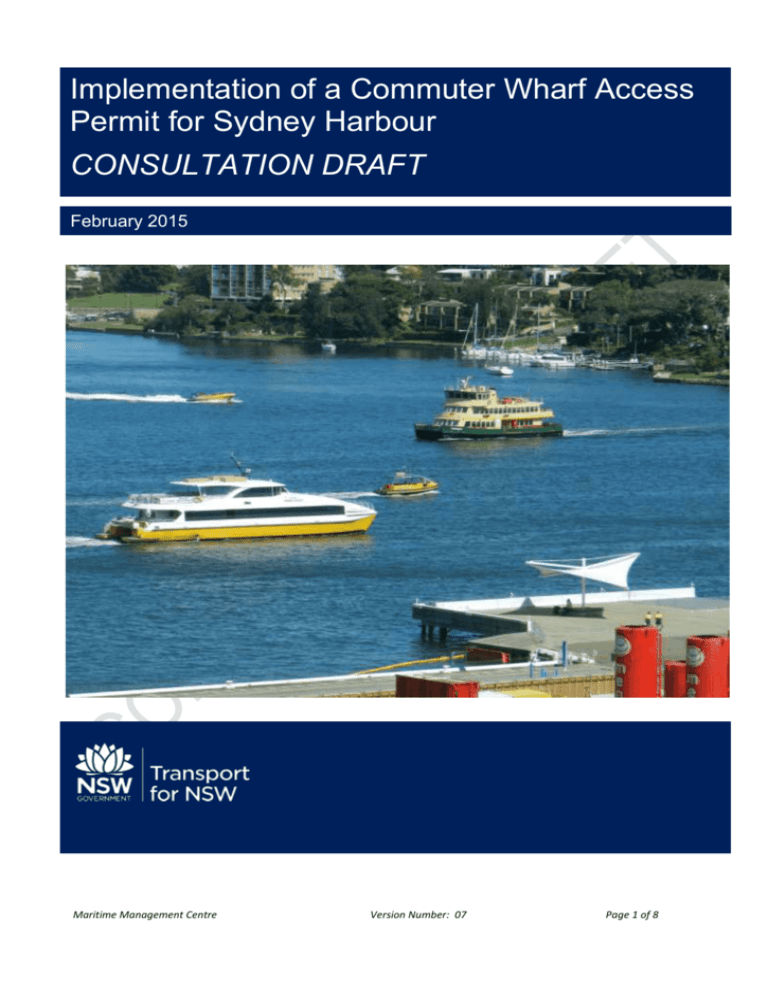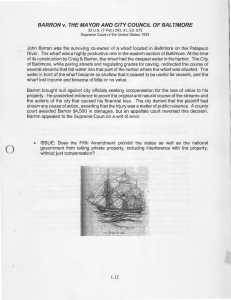- Commercial Vessels Association
advertisement

Implementation of a Commuter Wharf Access Permit for Sydney Harbour CONSULTATION DRAFT February 2015 Maritime Management Centre Version Number: 07 Page 1 of 8 1 Introduction ......................................................................................................................................................... 3 2 Scope.................................................................................................................................................................... 3 3 Nature of permit .................................................................................................................................................. 3 4 Compliance........................................................................................................................................................... 4 5 Options for monitoring wharf usage ..................................................................................................................... 4 5.1 Automatic Information Service (AIS) ....................................................................................................................... 4 5.2 RFID ......................................................................................................................................................................... 5 5.3 Remote Cameras / Existing Wharf Cameras ........................................................................................................... 6 5.4 Periodic Survey ........................................................................................................................................................ 6 5.5 Strengths and Weaknesses ...................................................................................................................................... 6 5.6 Conclusion ............................................................................................................................................................... 7 6 Regulatory framework.......................................................................................................................................... 7 7 Permit Conditions ................................................................................................................................................. 7 8 Implementation ................................................................................................................................................... 8 Attachment A - TfNSW Wharf Access Policy Attachment B - Draft Ports and Maritime Administration Amendment (Wharf Access) Regulation 2015 Maritime Management Centre Version Number: 07 Page 2 of 8 1 Introduction On 24 April 2014 Transport for NSW (TfNSW) announced a new Wharf Access Policy for Roads and Maritime (RMS) owned wharves on Sydney Harbour (Attachment A). A key element of this policy is the introduction of a Commuter Wharf Permit System that allows commercial passenger vessels to obtain a permit allowing them to access certain wharves on the harbour. The permit scheme will operate independently and separately to the existing RMS Charter Wharf Booking System which applies to wharves identified as Charter Wharves. A list of the Charter Wharves and Commuter Wharves is provided in the Wharf Access Policy. The permit scheme will allow permit holders to use the Commuter Wharves in order to pickup and set down passengers, with vessels occupying the wharf for less than 5 minutes. Permit holders will need to ensure that priority access is maintained for Sydney Ferries services. 2 Scope The number of Commercial Passenger vessels operating on Sydney Harbour varies due to seasonal and economic influences. RMS has advised that there are approximately 400 vessels that have their home port listed as Port Jackson that conduct commercial passenger operations. This includes vessels engaged in charter or water-taxi operations. In addition to this, there are a number of domestic commercial vessels that come with a National certificate or survey and operation from another state or territory who may benefit from utilising the permit scheme and are operating within Port Jackson. Under the scheme any commercial vessel seeking to pick up or drop off passengers at a Commuter Wharf will be required to obtain a permit1. 3 Nature of permit A Commuter Wharf Permit is issued for a period of 12 months and may cover one or more commercial vessels owned by a commercial vessel operator. Conditions may be applied to a Commuter Wharf Permit, for example, access to a particular wharf may be restricted to particular times of day to ensure priority access is maintained for Sydney Ferries services. A Permit does not provide a booking to use a wharf at a particular time and date, rather it allows a vessel to pick up and drop off passengers on a “touch and go” basis with berthing times limited to five minutes. 1 Services operating under a service contract to Transport for NSW under the Passenger Transport Act are exempt from the requirement to obtain a permit, where the service contract authorises use of a commuter wharf through other means. Maritime Management Centre Version Number: 07 Page 3 of 8 Permit holders providing services in accordance with a regular timetable will be given priority over other wharf users, except Sydney Ferries services which have priority over the services of all permit holders. Fees for a Commuter Wharf Permit are based on usage and are set out in the TfNSW Wharf Access Policy (Attachment A). Initial feedback from industry has suggested the need for a threshold of wharf usage, below which operators are not required to hold a permit. It has been suggested that there are some operators who generally operate outside of Sydney Harbour but may come into the harbour occasionally to operate charter services during major events. Further comment is sought to help determine an appropriate threshold that ensures very occasional wharf users are not unnecessarily impacted by the Permit Scheme. 4 Compliance There are two elements to ensuring compliance with the Commuter Wharf Permit scheme: a) Being able to identify when a commercial vessel is using a Commuter Wharf without the operator holding a permit. b) Being able to monitor how many times a permit holder berths at a Commuter Wharf over twelve month period. RMS’ Authorised Officers will undertake compliance activities to check whether an operator of a commercial vessel using a Commuter Wharf has a valid permit. This may include ‘spot checks’ or more targeted compliance campaigns including acting in response to reports and intelligence received from other operators. As it is neither practical nor cost effective to utilise a person with the sole responsibility of visually monitoring how often an operator berths at a Commuter Wharf, a technology based solution is required. 5 Options for monitoring wharf usage 5.1 Automatic Information Service (AIS) AIS was developed primarily to allow ships to view marine traffic in their area and to be seen by that traffic. The system uses a dedicated VHF AIS transponder that regularly transmits a package of information including vessel identification, location, orientation and speed. Port authorities or other shore-based facilities use AIS, so that they can view the local traffic without the need to transmit their own location. All AIS transponders are limited by VHF radio range, but numerous receivers can be utilised to improve reliability of reception. The information transmitted by vessels would be filtered by computer to identify when a vessel has used a wharf. Maritime Management Centre Version Number: 07 Page 4 of 8 The technology is already utilised by some of the larger / faster vessels that currently operate on Sydney Harbour. The Port Authority of NSW utilises AIS and manages base station receivers in AMP Tower and at La Perouse to assist with the monitoring of vessels in the Sydney region. Key points relating to the use of AIS for the Commuter Wharf Access scheme are listed below. The operation of a commuter wharf permit scheme that is capable of recording wharf use by compliant vessel operators with reasonable accuracy should be achievable through the use of AIS. A number of commercial passenger vessels on Sydney Harbour already have AIS installed and use it to supplement their navigational instrumentation on board the vessel. Operators would be required to be responsible for the purchase, install and operation of an appropriate transceiver for each vessel. AIS can be used by vessel masters as a supplementary navigational aid. Aside from the proposed requirement to operate AIS as part of the Permit scheme, and separate to any other legislative requirements, the installation of AIS on commercial passenger vessels inside port Jackson is supported by Port Authority of NSW, Roads and Maritime Services and the Office of Transport Safety Investigations. RFID 5.2 Radio Frequency Identification (RFID) is a technology that is in common use in numerous areas of society. Notably, RMS and other road managers use RFID technology to monitor road use on tollways and bill users accordingly. The standard hardware available for RFID systems can detect “tags” out to a range of 10 meters. A “base” reader would be required to be set up on each wharf. When a tag comes within range the reader would record the event and send the information by remote 3G telecommunications network to a central location where usage from all wharves would be recorded. Some larger vessels may require more than one tag to ensure the wharf use is correctly captured. Additionally, for this technology to be used effectively it must be paired with some form of optical recognition system. RMS use numberplate recognition software and road sensors to automatically photograph a vehicle passing an isolated point in the road. RFID would not be able to confirm unauthorised use without significant investment in cameras and incurring the ongoing cost of manual review. Noting the number of vessels that may be subject to the permit scheme, the level of compliance required to utilise RFID and the use of an operator to manually scan and check images captured may negate the benefits of RFID technology. RFID hardware would cost approximately $10,000 per wharf. Vessel tags cost approximately $5-$10 per unit for each vessel. Does not capture unauthorised use. Requires significant ongoing use of remote area cameras to determine unauthorised access. Maritime Management Centre Version Number: 07 Page 5 of 8 5.3 Provides minimal to no supplementary benefit to anyone when used with remote cameras. Remote Cameras / Existing Wharf Cameras Camera purchase and installation costs range from $3,000 to $5,000 per camera unit with ongoing 3G network fees of approximately $30 per unit / month applicable for data transfer to a central location. The use of remote cameras as a single means to record wharf use requires significant manual intensive work to record berthing – both legal and illegal. The use of current camera installations maintained by Sydney Ferries and supplementation of cameras where required on Commuter Wharves could be undertaken with supplementary benefit provided to a range of other stakeholders including HCF, Transport Management Centre, Maritime NSW and NSW Police. Roads and Maritime currently operate cameras that provide images of various areas within Sydney Harbour. The images that these cameras capture are not suitable for the purposes of providing satisfactory vessel identification for the Wharf Access Permit Scheme. 5.4 Periodic Survey Periodic Survey is defined as the use of manual labour placed on site to record the usage of wharves by various vessels and monitoring their compliance with the Wharf Access Scheme. Even if used at various times of the year to obtain a statistically relevant sample, the number of wharves that would need to be monitored and the hours of monitoring required would make this an unsatisfactory method of primary scheme management. However, the use of periodic survey while inherently inefficient and costly may have limited application where a problem area / wharf has been specifically identified and needs to be reviewed. 5.5 AIS RFID Strengths and Weaknesses Strengths Weakness Effectiveness Data rich. Reports wharf usage, dwell time, failure to provide access to Sydney Ferries. Improvements to marine safety. Introduction supported by NSW Ports & RMS. Provides vessels with an additional navigational aid if not already fitted. Established technology with existing examples of use available. Untested adaptive use of technology. Requires trial period to test operation. Should provide an automated report of wharf usage that can be displayed by scheme administrator. Also allows vessels to “see each other” and take action to minimise congestion. Limited. Does not show complete wharf use picture. Maritime Management Centre Does not capture use by vessels who do not have AIS. Limited information capture. Does not capture Version Number: 07 System Costs Capital / Recurrent Upwards $2k AIS / of $600 GIS per software vessel. and data Admin hosting. Software purchase up to $3k. $205k System + $8 per $7k $24k per month Page 6 of 8 Remote Camera Could assist TfNSW / Sydney Ferries with demand management and provide improved wharf security. Images can be retrieved for use at a later date as required for evidence. Periodic Survey Confirms wharf use. Proven low technology solution. vessels that do not have RFID tag. Labour / cost intensive. Motion sensing cameras still require review and manual administration. Reflections on water plus pedestrians can trigger camera even with advanced “sectorisation” of motion sensing camera field. Not covert and may not be seen as a deterrent unless utilised extensively. tag. May be useful at targeted problematic wharves. $3k-$5k per camera May be useful at targeted problematic wharves. Nil reporting package. $30 per mth per camera. Requires labour intensive image review. $25 per hour, per wharf. Costs do not include TfNSW general administration costs 5.6 Conclusion Based on the above analysis the use of AIS technology would appear to primarily provide the most effective and efficient means for monitoring wharf usage. Industry feedback is sought to help confirm this conclusion and identify any implementation or operational issues. 6 Regulatory framework It is proposed that introduction of the Permit Scheme will be supported by an amendment to the Ports and Maritime Administration Regulation 2012. A draft version of the regulation is provided at Attachment B for comment. 7 Permit Conditions The proposed regulation provides for the inclusion of conditions to a Commuter Wharf Permit, with possible penalties to apply if a permit holder does not comply with the conditions. It is proposed that the conditions will generally relate to the following issues: Requirement to pay the wharf access fee associated with the relevant wharf usage category. Requirement for vessels to have AIS operational with the correct vessel details transmitting when operating inside Sydney Harbour. Wharves may be closed or access restricted for operational reasons (eg maintenance) or if usage of the wharf by permit holders impacts on the priority access afforded to Sydney Ferries. Arrangements for suspending or cancelling a permit in the event of breach of a condition. Maritime Management Centre Version Number: 07 Page 7 of 8 Arrangements for permit renewal, noting that it is intended renewal will simply be a matter of paying the relevant fee for the next period. Refund arrangements should an operator seek to cancel a permit. 8 Implementation It is proposed to commence the Permit Scheme on 1 July 2015, with operators able to obtain a permit from May 2015. An initial amnesty period is being considered to assist operators with the transition to the new system, including an initial free access period where operators can obtain a permit without having to pay the relevant fee. Industry comment is sought on measures which may assist with implementation. Maritime Management Centre Version Number: 07 Page 8 of 8






